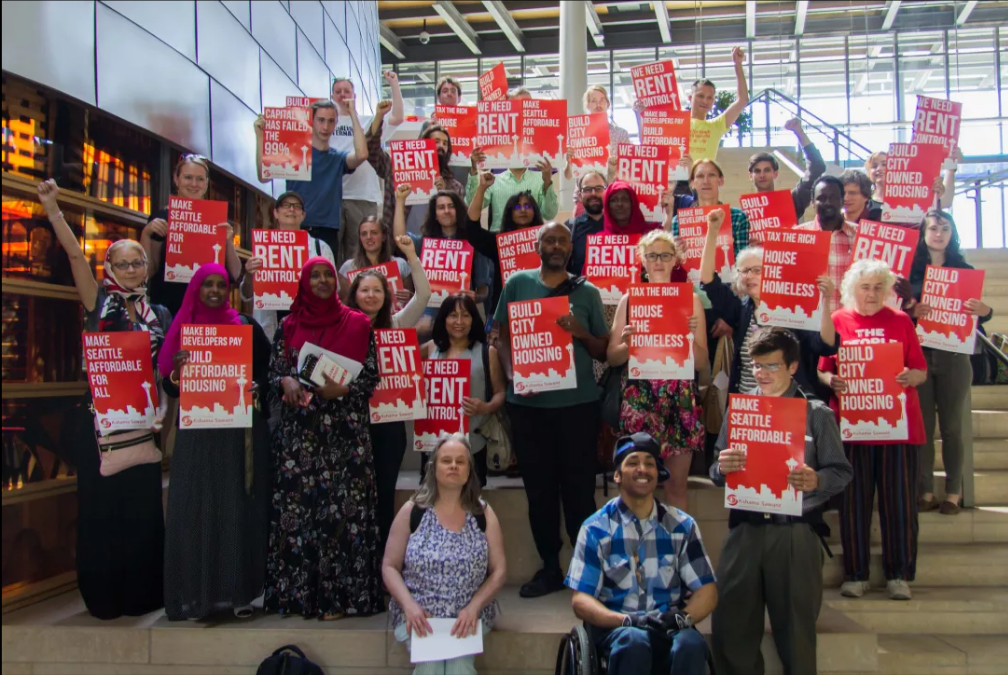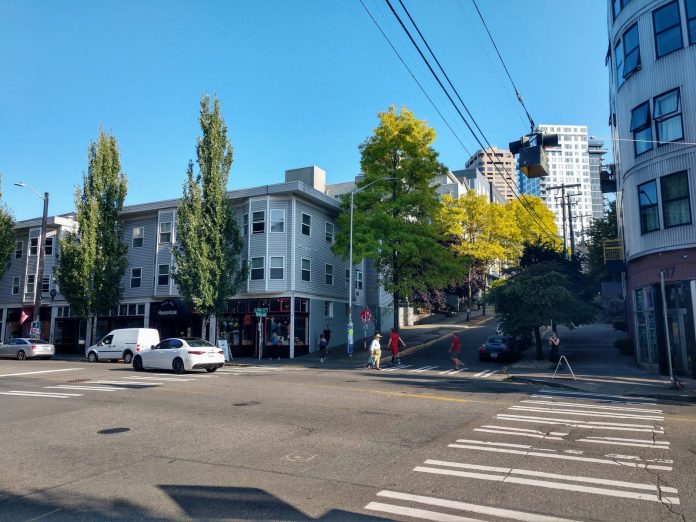If you’ve taken introductory economics, you’ve likely heard some bad things about rent control. Most economists (e.g., 81%) don’t like it. Generally, economists argue rent control restricts housing supply and is counterproductive to affordability in the long-term. But could that consensus be eroding?
Seattle rents doggedly continue skyrocketing, and politically rent control is making a comeback. The Oregon legislature passed rent control earlier this year becoming the first state to do so. Some Seattle tenants are beginning to wonder: why not here too?
And some housing advocates are wondering how we can ignite a tenant movement to seize political power without rent control to galvanize people by offering a clear material benefit. Alex Baca, among others, has argued rent control could unite a coalition that gets harder-to-explain things like zoning reform passed.
A Brief History of Rent Control Bans
Until recently, most of the momentum had been in the opposite direction–with several cities repealing, weakening, or preempting rent control policies in the 1980’s and 1990’s. For example, Cambridge, Massachusetts repealed its rent control system in 1994. Washington and Oregon implemented rent control bans in the early 1980’s amid Reagan fever, which set off a wave of bipartisan enthusiasm for deregulation and stomping on the poor.
In California, where rent control was in place in cities like Los Angeles, San Francisco, and Oakland, the state legislature kneecapped rent control by passing the Costa-Hawkins Rental Housing Act in 1995. The Costa-Hawkins Act prevents cities and counties from imposing rent control on single-family homes, on condominiums, or on apartments built after the last local rent control ordinance was passed prior to the act–for Los Angeles that means apartments built after 1978, apartments built after 1979 for San Francisco, and for Oakland after 1980. The law also prohibits vacancy control, which means that California landlords could raise rents as high as they like for the next tenant when a tenant moves out of a rent-controlled unit.
The Oregon State Legislature repealed its ban in 2016, responding to a housing affordability crisis in the state and clearing the way for statewide rent control passage. Washington did no such thing despite experiencing a similar (if not worse) rent crisis, although Representative Nicole Macri (D-Seattle) did introduce a repeal bill that ended up dying in committee.
California’s experience was different from Oregon’s. Expanding rent control was on the ballot in 2018 as Initiative 10. If passed, Initiative 10 would have repealed the Costa-Hawkins Act, but that initiative failed with only 40% of the vote. Tenants groups were outspent three-to-one by landlord groups. Initiative 10 backers are gathering signatures to bring back a modified initiative in 2020 that would alter rather than completely repeal the Costa-Hawkins Act. Instead of allowing for universal rent control, the new version would make it so that any apartment built before 2006 could be rent controlled, adding more than 20 years worth of apartment construction to the rolls in cities that had rent control.
Based on how badly the 2018 vote went, California’s 2020 initiative faces a uphill battle to cross the 50% threshold. In addition to being outspent, Initiative 10 may have suffered from its primary backer in the AIDS Healthcare Foundation being known for suing to block new apartment buildings near its Hollywood headquarters, in part because their tower’s majestic views would have been blocked. A better messenger and a better crafted policy could potentially convince the electorate that expanding rent control was intended to provide renter relief rather than choke production of housing.
That said, AIDS Healthcare Foundation continues to be the main backer of the 2020 initiative effort. Arguably, Seattle has a similar problem in that John Fox was historically at the forefront of failed rent control efforts. Fox lately has been known for opposing inclusionary zoning, aligning with anti-housing homeowner groups, and cooking his statistics. At its best, rent control would be paired with pro-housing-growth policies.

Councilmember Kshama Sawant has made rent control a central plank of her platform dating back to her initial city council bid in 2013, and she continues to press on that front and is running on it in 2019. The Urbanist Election Board (of which I am a member) endorsed Councilmember Sawant in her reelection bid in Council District 3, which covers First Hill, Capitol Hill, the Central Area, Montlake, and Madison Park. In advance of a Renters’ Rights Commission meeting, she is rallying supporters to turn out to a September 23rd renters right committee meeting at Seattle City Hall.
At the national level, Senator Bernie Sanders (D-Vermont) published a pro-rent control op-ed for CNN last week. Growing up, Senator Sanders wrote, rent control helped keep a roof over the head of his lower-middle class family and helped lessen their financial worries. Senator Sanders isn’t proposing nationwide rent control, but he does want to empower local jurisdictions to make that choice, while boosting federal funding for affordable housing and encouraging inclusionary zoning. Similarly, Senator Elizabeth Warren (D-Massachusetts) called out rent control bans in her robust housing platform and pledged support for repealing state rent control bans so cities can make their own choices.
Rent Control’s Benefits
While rent control may be gaining political support, it’s probably safe to say economists have not warmed as quickly. Still, some researchers are coming around.
Historically, economists often narrowly defined the benefits of rent control to only money saved on rent by beneficiaries–which was weighed against losses measured more generously. Economic analysis often focused on market distortion and did not placed a value on the sociological benefits of housing stability–things like being able to keep kids in the same school or maintaining social support networks. A recent paper by Columbia professor Stijn Van Nieuwerburgh measured those ancillary benefits within New York City’s rent-controlled housing stock and found dramatically different results.
“The new research debunks conventional economic wisdom, finding evidence that rent control does not lead to an overall decline in the quantity of housing,” a press release for the paper states. “The research also finds that the overall positive impact of rent control–reducing inequality and providing a source of stability for households who face a decline in income–more than compensates for any loss in market efficiency–due to higher housing and labor market distortions.”
“Economists typically have taken a narrow view towards rent control, preferring other options like vouchers for low-income and rent-burdened residents because they cause less distortion to the housing market. But we’ve found that expansion of rent control in major cities provides real benefits,” Van Nieuwerburgh said. “Better targeting of rent controlled housing units towards the lowest-income households can amplify these benefits.”
Adding to literature sympathetic to rent control, the Haas Institute published a policy brief in 2018 backing rent control and disputing a paper by UC Berkeley economist Ken Rosen that blamed rent control for California’s housing shortage. “Housing production and tenant protections are needed, but only rent control will provide a near-term solution for renters,” the authors wrote.
Rent Control versus Rent Stabilization
The difficulty of discussing rent control is there really is a wide variety of policies. The first generation of rent control, which kicked off in the 1920’s, was often a hard rent cap applied broadly–in other words a conventional price ceiling that market-oriented economists loath. However, the more recent wave of rent control often includes provisions favoring housing production (e.g., exempting new apartments) and allowing landlords to make a reasonable profit by allowing modest rent increases each year often pegged to inflation. Second-generation rent control often includes vacancy decontrol allowing landlords to set rents between tenancies unencumbered, as the Costa-Hawkins Act established in California.
Interestingly, some economists ignore these differences to make sweeping generalizations about all rent control policies. Does rent control still hinder housing production if it doesn’t apply to new buildings and only can apply to four-decade-old apartment buildings like in California? It’s hard to draw a causal connection for why rent control for old buildings would hinder the supply of new housing in a high-demand city, short of a slippery slope argument. Nonetheless, many economists seem to argue this. It seems to be a tenet of the Glaeser School, led by Harvard economist Ed Glaeser, a prominent urbanist who tends to oppose regulations of most kinds.
Because rent control was discredited in mainstream politics and neoliberal thinking, tenant groups and their allies have sometimes avoided the term. Some now use the term “rent stabilization” to draw a distinction from the more strict rent control forms of the past that were seen as clapping down on new housing. Rent stabilization policies typically allow fairly significant rent increases year to year, but prevent landlords from large rent hikes, such as those used to economically evict tenants in order to skirt tenant protections. So once again to summarize:
- First-generation rent control tends to set a strict price ceiling or rent freezes.
- Second-generation rent control tends to allow rent increases that are moderated in older buildings as long as a tenant stays, but landlords can jack up rents after that tenant leaves.
- Rent stabilization is a rebranding of second-generation rent control policies to emphasize its difference from strict rent control and avoid the stigma against it.
Much of the economics consensus against rent control appears to founded upon papers tearing down first-generation rent control policies. The influential 1946 paper by Milton Friedman and George Stigler is an example of this.
The Housing Supply Debate
Research like the Van Nieuwerburgh and Haas Institute papers have poked holes in the consensus that rent control, even in its weaker second-generation forms, hinders housing production and lowers housing supply. An Urban Institute literature review from January 2019 noted the predicted supply effects are not found in empirical studies.
Most research on rent-control laws has come from economics literature, where it is often referenced in introductory texts as a classic case of an ineffective and counterproductive policy. Economists argue that rent controls reduce incentives to maintain existing housing or build new housing, leading to a growing mismatch between housing supply and demand and an increase in prices overall. Because contemporary rent-control policies usually have features that mitigate some of these negative impacts, however,this general critique is less salient when applied to real-world examples, and empirical studies looking into these effects have found mixed results. More broadly, economic analyses often ignore other social benefits associated with neighborhood stability, displacement prevention, and inclusivity.
Prasanna Rajasekaran, Mark Treskon, and Solomon Greene – Urban Institute
Specifically, Rajasekaran and his coauthors note that empirical studies in New Jersey and Washington, D.C. failed to detect a relationship between second-generation rent control and housing production: “Some authors have argued that rent-control policies may affect developers’ willingness to build new housing (Early 2000; Glaeser 2003), but because US rent-control laws generally exempt new construction, the causal mechanism potentially at work here is unclear. Empirical work that has tested these expectations in New Jersey and the District of Columbia found no significant relationship between rent control and new housing construction (Gilderbloom and Ye 2007; Turner 1990).”
While the ECON 101 model suggests second-generation rent control would increase rents in the unregulated market due an overall shortage of housing, some studies have suggested the opposite can happen due to spillover effects. “[T]wo studies of a 1994 decontrol initiative in Cambridge, MA, find that rent control actually reduced rents in the uncontrolled sector (Autor, Palmer, and Pathak 2014; Sims 2007),” the Urban Institute review states. “Authors in these studies argue that this was caused by spillover effects: landlords of controlled units were less likely to pay for upkeep, causing nearby uncontrolled units to decrease in value. This meant that the benefits of lower rents (even for units in the uncontrolled sector) came at the cost of quality deterioration.”
Strict first-generation rent control that apply to new buildings obviously would factor heavily into a developer’s decision to build–or into a banker’s decision to lend money to said developer. However, if new buildings are exempt, it’s not clear rent control would hinder the profitability of a new project. As such, the empirical research has struggled to find supply effects stemming from second-generation rent control.
Even if, as in Oregon’s recent example, new apartment buildings are exempt from rent control for their first 15 years, landlords are still allowed to bank plenty of revenue before rent stabilization kicks in. And when Oregon’s rent stabilization does kick in, it still allows for rent increases of 7% plus the rate of inflation (as determined by the consumer price index). That means a fairly large rent hike (approaching 10%) would still be permitted on an annual basis.
There’s no reason to expect a landlord would need to implement double-digit rent increase 16 years into a building’s life. Thus, Oregon’s rent stabilization law wouldn’t really factor into the math of a developer’s decision to build or not build a project. If a developer’s financial plan involved such aggressive rent hikes 20 years down the road, banks and investors are not going to trust the plan–it would be seen as too risky. Nonetheless, Oregon’s landlord lobby vigorously opposed the law with the same talking points as a first-generation rent control law would see.
What Oregon’s rent stabilization does do is compliment other tenant protections. Rather than providing an obvious backdoor for landlord to evict tenants via huge rent hikes, the Oregon law limits that option, increasing the effectiveness of other tenant protections, such as just cause eviction rules.
No Silver Bullet
The Urban Institute literature review was generally positive, but the authors stress that rent control policies must be designed to avoid some of the worst side effects and should not be relied on to singlehandedly fix housing markets. Instead, rent control should “fit into a broader framework of effective housing policies that promote inclusion and limit displacement.”
One extreme example is Vienna, Austria, which has progressive zoning, massively funds social housing, and maintains rent stabilization through public or nonprofit ownership of most of its housing stock. In fact, Vienna used rent control to bring about its housing miracle. During the Red Vienna period, the City used rent control to drive down property prices then bought up lots of apartment buildings. A blunt and hard to replicate method, but it worked. Vienna is considered one of the most affordable and livable cities in the world. Since so much land is in public hands, the City has acted as the primary developer basically ever since, running competitions to come up with the best designs for a particular plot–designs must excel on affordability and eco-friendliness.

Well-designed rent control policies can help promote racial equity, but undoing centuries of racist policy requires a systemic approach, and no one policy–even one as dramatic as rent control–will work alone.
“If rent control is judged on its ability to promote stability for people in rent-controlled units, evidence has generally found it to be successful,” they wrote. “Research on rent control’s effects on the broader housing market (whether on rents, construction, or conversion) have yielded mixed results. However, evidence is also mixed for rent control’s ability to promote economic opportunity or reduce racial disparities. Part of this stems from a trade-off: promoting stability may, over time, lead to a growing mismatch between people who live in a rent-controlled unit and people who need one.”
For Washington state, repealing the state ban will be step one. Councilmember Sawant is demanding universal rent control, but just what the ideal policy for Seattle is remains up for debate. Making rent control part of Seattle’s housing solution does seem like it could energize tenants and expand the pro-housing coalition. And that alone should be reason enough for urbanists to give rent stabilization a hard look with an open mind.
Doug Trumm is publisher of The Urbanist. An Urbanist writer since 2015, he dreams of pedestrian streets, bus lanes, and a mass-timber building spree to end our housing crisis. He graduated from the Evans School of Public Policy and Governance at the University of Washington in 2019. He lives in Seattle's Fremont neighborhood and loves to explore the city by foot and by bike.


